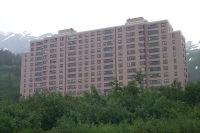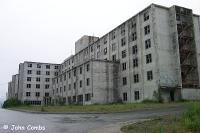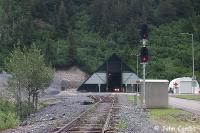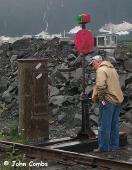Current Population: 265 (as of
2022)
Incorporation Type: 2nd
Class City
Borough Located In: Unorganized
Taxes: Sales: 5%; Property: 8.0 mills; None
City: City of Whittier,
P.O. Box 608, Whittier, AK 99693, Phone 907-472-2337 , Fax 907-472-2404
Whittier is on the northeast shore of the Kenai Peninsula, at the head of Passage Canal. It is on the west side of Prince William Sound, 75 miles southeast of Anchorage. The area encompasses 12 square miles of land and 7 square miles of water. Winter temperatures range from 17 to 28; summer temperatures average 49 to 63. Average annual precipitation includes 66 inches of rain and 80 inches of snowfall.
Be sure to read this great article entitled Pride and progress in Whittier
 The
city originated as a portage route for the Chugach Indians who were traveling
from Prince William Sound to Turnagain Arm to fish. Nearby Whittier
Glacier was named for the American poet John Greenleaf Whittier, and was
first published in 1915 by the U.S. Coast & Geodetic Survey.
By August 8, 1921 Whittier
was becoming a bustling little town. In November 1941, a port and
railroad terminus project was undertaken by the U.S. Army for transport
of fuel and other supplies into Alaska during World War II. On December
7, 1941 the Japanese struck Pearl Harbor. On November 20, 1942, the
"holing through" ceremonies were held on the Whittier-cutoff. The
railroad spur was completed in 1943, and the Whittier Port became the entrance
for troops and dependents of the Alaska Command. The first passenger
train was run through the Whittier tunnels on March 10, 1943. The
train backed through so guests could observe tunnels from the observation
platform. The Portage tunnel is 4,905 feet long and Whittier tunnel
is 14,140 feet.
The
city originated as a portage route for the Chugach Indians who were traveling
from Prince William Sound to Turnagain Arm to fish. Nearby Whittier
Glacier was named for the American poet John Greenleaf Whittier, and was
first published in 1915 by the U.S. Coast & Geodetic Survey.
By August 8, 1921 Whittier
was becoming a bustling little town. In November 1941, a port and
railroad terminus project was undertaken by the U.S. Army for transport
of fuel and other supplies into Alaska during World War II. On December
7, 1941 the Japanese struck Pearl Harbor. On November 20, 1942, the
"holing through" ceremonies were held on the Whittier-cutoff. The
railroad spur was completed in 1943, and the Whittier Port became the entrance
for troops and dependents of the Alaska Command. The first passenger
train was run through the Whittier tunnels on March 10, 1943. The
train backed through so guests could observe tunnels from the observation
platform. The Portage tunnel is 4,905 feet long and Whittier tunnel
is 14,140 feet.
The Alaska Railroad's first diesels numbers 1000 and 1001 arrived at Whittier on June 9, 1944. They were standard 1000 HP switching locomotives built by the American Locomotive Company.
Under agreement with the Army, the Alaska Railroad took over operations at Whittier on December 17, 1945, replacing soldier forces there. The Army also released 85 enlisted men for railroad employment as longshoreman.
 The
huge buildings that dominate Whittier began construction in 1948. The Hodge
Building (now Begich Towers) was built for Army
bachelors quarters and family housing. The Buckner Building, completed in
1953, was once the largest building in Alaska, and was called the "city under
one roof." The Port remained an active Army facility until 1960; at that time,
the population was 1,200. During the earthquake of 1964, Whittier, being
the closest city to the epicenter, suffered
incredible damage. The Buckner Building was not repaired
following the earthquake and stands unused. The City was incorporated
in 1969. The Begich Building is now a condominium, and house nearly all of Whittier's
residents. There's even an underground tunnel from the building to the
school house so the children don't have to go outside during the winter.
The
huge buildings that dominate Whittier began construction in 1948. The Hodge
Building (now Begich Towers) was built for Army
bachelors quarters and family housing. The Buckner Building, completed in
1953, was once the largest building in Alaska, and was called the "city under
one roof." The Port remained an active Army facility until 1960; at that time,
the population was 1,200. During the earthquake of 1964, Whittier, being
the closest city to the epicenter, suffered
incredible damage. The Buckner Building was not repaired
following the earthquake and stands unused. The City was incorporated
in 1969. The Begich Building is now a condominium, and house nearly all of Whittier's
residents. There's even an underground tunnel from the building to the
school house so the children don't have to go outside during the winter.
During the April 1990 U.S. Census, there were 265 total housing units, and 153 of these were vacant. 126 jobs were estimated to be in the community. The official unemployment rate at that time was 8%. 37% of all adults were not in the work force. The median household income was $33,636, and 13% of residents were living below the poverty level. The main economy of the town is generated by the small boat harbor mainly from commercial and sport fishing.
 Whittier
is an ice free port and a 70' city dock. A small boat harbor has slips for 360
fishing, recreation and charter vessels. It is served by the state ferry, barges,
rail, and aircraft. Prior to June 2000, the town was not accessible by
road and the railway carried passengers,
vehicles and cargo 12 miles to the Portage Station, east of Girdwood. Travelers
then drove to Anchorage or Kenai on the Seward Highway. An $80 million
road connection project permitted vehicular traffic to share the 2.5 mile tunnel
with the railroad. Thus, the Whittier shuttle no longer accommodates vehicles
riding on flat cars.
Whittier
is an ice free port and a 70' city dock. A small boat harbor has slips for 360
fishing, recreation and charter vessels. It is served by the state ferry, barges,
rail, and aircraft. Prior to June 2000, the town was not accessible by
road and the railway carried passengers,
vehicles and cargo 12 miles to the Portage Station, east of Girdwood. Travelers
then drove to Anchorage or Kenai on the Seward Highway. An $80 million
road connection project permitted vehicular traffic to share the 2.5 mile tunnel
with the railroad. Thus, the Whittier shuttle no longer accommodates vehicles
riding on flat cars.
Two railroad related projects are currently underway in Whittier. As of 2/21/2001 Crowley will no longer be providing barge services to the Alaska Railroad. In a bidding process conducted last year the ARRC decided to go with Lynden, Inc., which is in the process of building three new barges for the service plus a new barge dock in Whittier. Secondly, the railroad is going to raze its old warehouse leaving only the section house.
The Alaska Railroad also maintains a large docking system in Whittier.
Click here to view the Whittier yard diagram
Aerial drone video of Whittier
Huna Totem team up with Norwegian Cruise Lines to install a new cruise ship facility

A switch heater keeps ice
from building up in the points
Whittier Aerial Photos
Unauthorized use prohibited
Page was created 12/1/99 and last updated 4/29/24